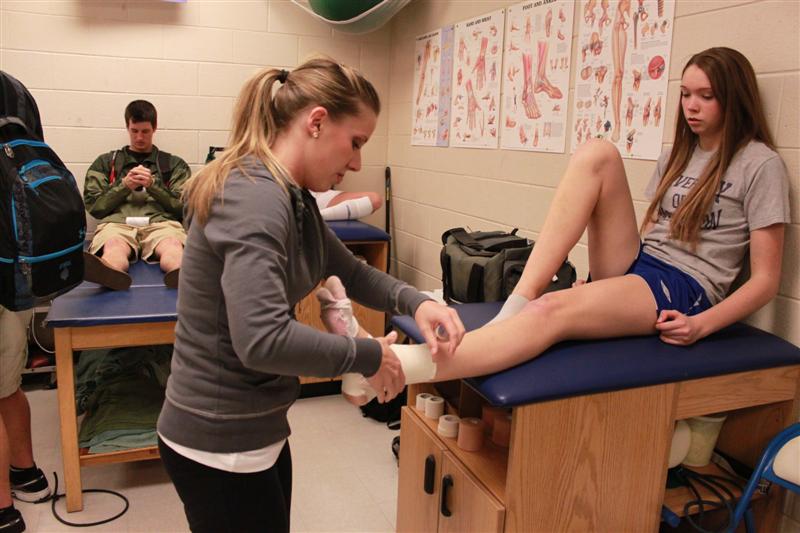You are running down the field toward the goal when you land on your back, winded, wondering what just happened and why your knee is throbbing. This is where an athletic trainer comes in. They diagnose injuries, help athletes recover, and get them back on the field as fast as possible.
LZHS has two part time athletic trainers, Michael Klobnak, PE teacher, and Elizabeth Eckert, health teacher. Klobnak handles fall sports and Eckert trains in the winter season.
“I was a student trainer with my high school and that led to my getting a college scholarship,” Eckert said. “I knew from a really early age that this was something I wanted to make a living at later in life.”
Athletic trainers take on many responsibilities, including assessing and responding to injuries, wrapping and taping, rehabbing injuries, and communicating with the athletes, coaches, parents, and the athletic director. The injuries themselves can vary greatly, Eckert said.
“There are such a wide range of injuries we deal with. There’s the kind we rehab, which are mostly strains and sprains,” Eckert said. “The kind we call an ambulance for are mostly accidents.”
Trainers not only take care of injuries, they deal with daily maintenance for injuries, such as icing or wrapping. Without the care and treatment from trainers, athletes would be less prepared to play or could risk reinjuring themselves due to lack of knowledge about their injury. Students are the focus of athetic trainers, and a big reason why they do what they do, according to Klobnak.
“[My favorite part of being an athletic trainer is] getting to know the kids while you’re treating them, and seeing them practice and play again once they get better,” Klobnak said. “When [Zach] Till got hurt, I got to know him really well through the whole proccess, although it’s hard a lot of time since we have so many athletes.”
Matthew Moon, sophomore, is a football, basketball, and baseball player who sprained his right wrist after another player pushed him in basketball. He has been a regular in the trainers’ area since then, and has followed a rehab program with some less conventional exercises.
“I do stretches with the bands and silly putty [to help my hand],” Moon said. “I’ve been working on getting my hand back to full strength for a couple months now and it’s going pretty well.”
Stephanie Jameson, a trainer the school contracted from AthletiCo to help with the training during the whole school year, treated and rehabbed Moon after he injured his wrist. Jameson is here for the year to help with the training, as Klobnak and Eckert both teach and can only help students after school.
LZHS has three trainers, but many schools do not have any to help student athletes. This can affect athlete performance, especially if an injury is not treated properly, according to Eckert. This is a problem, as everyday kids are injuring themselves while playing sports.
“We live in an area where most schools have athletic trainers,” Eckert said. “A very small percentage of schools in some states have trainers. We’re very lucky.”
Athletic trainers help raise awareness of the need to assess injuries. While LZHS has trainers to take care of athletes, many schools do not, according to Eckert. Klobnak agrees that times have changed; therefore athletes’ needs have changed too.
“If we got hurt in my high school you went to the doctor and that was about it. The coaches tried to take care of you, but they had limited knowledge,” Klobnak said. “You had to suck it up, or walk it off. We didn’t have athletic trainers and the stuff you guys have.”
In high school athletics every year, there are over two million student athlete injuries and out of these only 500,000 doctor visits as a result of the work of athletic trainers. Due to their ability to care for athletes, few students have to do follow ups with doctors and specialists, which can be costly. Athletic trainers are incredibly important and a large part of staying able to play, according to Moon.
“They know what’s wrong with me more than I do,” Moon said. “They really help kids with injuries recover quickly.”

